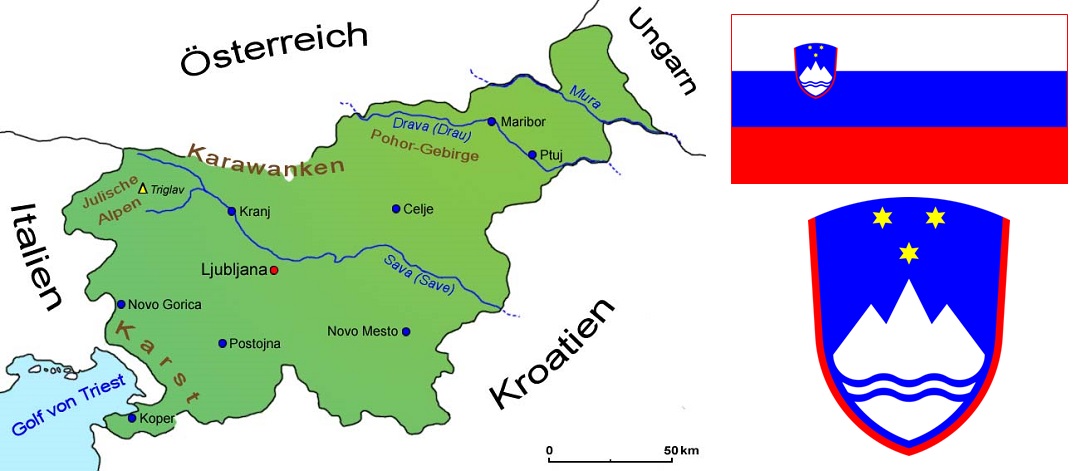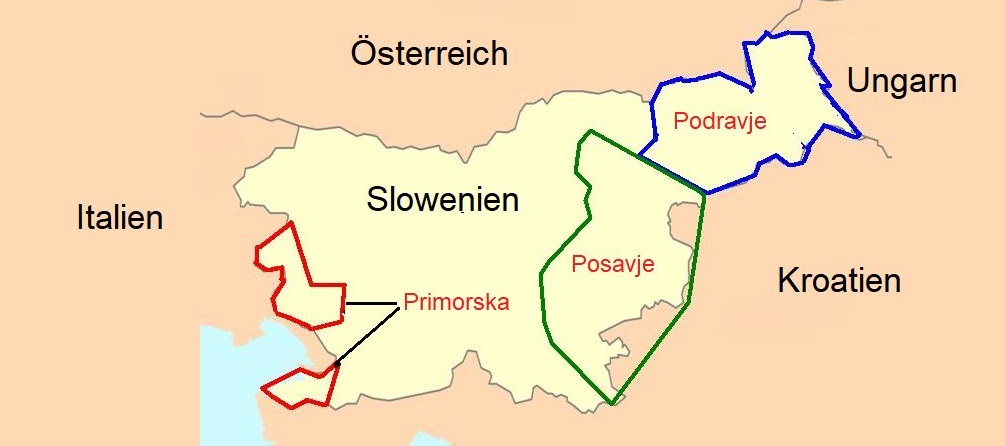Results
2,284 Results
Loading more Results ...
Loading more Results ...
Description to Slovenia
The Republic of Slovenia (Slovenija in Slovenian) with its capital Ljubljana covers an area of 20,273 square kilometres. The country borders Italy to the west, Austria to the north, Hungary to the east and Croatia to the south-east. After the end of the Second World War in 1945, Slovenia existed as a constituent republic of socialist Yugoslavia. Following the declaration of independence in 1991 and the 10-day war, Slovenia became an independent nation state.

History
The first vines were planted by the Celts around 2,400 years ago. The Romans influenced viticulture, particularly in the Poetovium region (Ptuj = Pettau). The Roman wine writer Pliny the Elder (23-79) mentioned viticulture in the Karst region and described these wines as the elixir of life. Viticulture came to a standstill again during the Migration Period. But in the Middle Ages, the wines were highly prized at the courts of imperial Vienna and archbishopric Salzburg. The Austrian Archduke Johann (1782-1859) owned a model vineyard near Maribor (Marburg). The influences of the region's long historical affiliation with Austria-Hungary can still be felt today. As in most European countries, large areas of vineyards fell victim to phylloxera in the second half of the 19th century.
Climate & soils
The climatic conditions are characterised by Alpine, continental and Mediterranean climates. Short, heavy downpours in spring are followed by a warm summer and a long, mostly sunny autumn, which enables a late grape harvest and thus also ripe Prädikat wines. The soils are characterised by great diversity (see under the wine-growing regions).
Wine-growing regions
The wine-growing areas lie to the north on the border with Austria (South Styria), to the east with Hungary and to the west with the Italian region of Friuli-Venezia Giulia. Around three quarters of production is accounted for by white wines and around one quarter by red wines. The Movia winery is a model and pioneer. There are many small winegrowers with tiny plots. Slovenia is divided into three large wine-growing regions with 14 protected wine-growing areas.

Podravje (Drauland) with 9,650 ha
Is divided into two areas:
Stajerska Slovenija (Slovenian Styria) with 8,685 ha
- Haloze
- Ljutomer-Ormoz
- Maribor
- Ptuj-Srednje Slovenske Gorice
- Radgona-Kapela
- Smarje-Virstanj
Prekmurje with 965 ha
- Lendavske Gorice-Goricko
Posavje (Sava region) with 4,328 ha
- Bela Krajina (White Carniola) with 608 ha
- Bizeljsko Sremič with 1,264 ha
- Dolenjska with 2,456 ha
Primorska (Adriatic coastal area) with 8,081 ha
- Goriška Brda (Gorizia hills) with 1,992 ha
- Kras (Karst) with 753 ha
- Slovenska Istra (Slovenian Istria) with 2,331 ha
- Vipavska Dolina (Wippach Valley) with 3,005 ha
Grape variety index
In 2022, the vineyards covered 14,789 hectares and the wine production volume was 546,000 hectolitres. The grape variety index (Kym Anderson statistics):
Grape variety |
Synonyms in Slovenia |
Colour |
Hectare |
| Welschriesling | Laski Rizling | white | 1.935 |
| Terrano / Refosco | Refošk, Refosco d'Istria | red | 1.340 |
| Chardonnay | - | white | 1.181 |
| Sauvignon Blanc | Muškatni Silvanec | white | 1.121 |
| Malvazija Istarska | Istrska Malvazija, Polijsakica Drnovk | white | 915 |
| Žametovka | Kavcina Crna | red | 822 |
| Merlot | - | red | 817 |
| Blaufränkisch | Frankovna Crna | red | 709 |
| Riesling | Renski Rizling | white | 607 |
| Ribolla Gialla | Rebula | white | 597 |
| Muscat Blanc | Rumeni Muscat | white | 586 |
| Furmint | Šipon | white | 546 |
| Pinot Gris | Sivi Pinot | white | 508 |
| Pinot Blanc | Beli Pinot, Beli Burgundec | white | 424 |
| Cabernet Sauvignon | - | red | 423 |
| Sauvignonasse | Zeleni Sauvignon | white | 231 |
| Savagnin Blanc | - | white | 209 |
| Pinot Noir | - | red | 202 |
| Kraljevina | - | white | 199 |
| Müller-Thurgau | Rizvanec | white | 128 |
| Kerner | - | white | 111 |
| Barbera | - | red | 98 |
| Muscat Ottonel | white | 98 | |
| Plavec Žuti | Rumeni Plavec | white | 82 |
| Silvaner | - | white | 81 |
| Blauer Portugieser | - | red | 80 |
| Zelen | - | white | 75 |
| Pinella | - | white | 61 |
| Vitovska Grganja | Vitouska | white | 51 |
| Cabernet Franc | - | red | 27 |
| Syrah | - | red | 18 |
| St Laurent | - | red | 6 |
| Zweigelt | - | red | 5 |
| Gamay | - | r0t | 4 |
Wine categories
As in Austria and Germany, these are based on the must weight of the grapes. The label must indicate the number of bottles or litres produced. The sweetness levels are suho (dry), polsuho (semi-dry), polsladko (semi-sweet) and sladko (sweet). In August 2009, the EU wine market regulation came into force with fundamental changes to wine designations and quality levels. The following new designations and quality levels have been introduced (see quality system):
- Vino (formerly Namizno Vino or table wine) = wine
- PGO = Deželno Vino or country wine
- ZGP = Kakovostno Vino or quality wine
- VV z ZGP = Vrhunsko Vino or top wine / predicate wine
- PTP = Priznano Tradicionalno Poimenovanje or traditional wine
PGO (Priznano Geografsko Oznaka)
recognised geographical designation)
Wine made from fully ripe grapes, natural alcohol content max. 8.5% vol, maximum yield 120 h/ha, sensory and analytical testing required.
ZGP (Zaščitenim Geografskim Poreklom)
Protected geographical origin
The use of quality wine grape varieties and specific vineyards are required, fully ripe grapes, natural alcohol content of 8.5% vol (9.5% vol in wine-growing zone CII), maximum yield of 80 hl/ha, sensory and analytical testing required, official tasting must achieve 16.1 out of 20 points.
VV z ZGP (Vrhunsko Vino z Zaščitenim Geografskim Poreklom)
Top wine of protected geographical origin
This corresponds to a Prädikat wine. In addition to the basic criteria, the following conditions apply Declared grape harvest, no enrichment and no additives permitted, no deacidification. At least 18.1 out of 20 points must be achieved in official tastings. Additional designations/wine types listed:
- Pozna Trgatev = late harvest (overripe or botrytised; to 92 °Oe)
- Izbor = Auslese (overripe or botrytised; to 108 °Oe)
- Jagodni Izbor = Beerenauslese (overripe or botrytised; at 128 °Oe)
- Suhi Jagodni Izbor = Trockenbeerenauslese (overripe or botrytised; at 154 °Oe)
- Ledeno Vino = Ice wine (naturally frozen at harvest, at 128 °Oe)
- Slamno Vino (Vino iz Sušenega Grozdja) = Straw wine (dried on reed mats)
PTP (Priznano Tradicionalno Poimenovanje)
recognised traditional designation)
Wines produced according to traditional methods with protection of geographical origin. There are only four of these: Belokranjec, Cviček, Kras Teran and Metliska Crnina.
Special wine designations/types
- Arhivsko Vino = archive wine (matured for 2 years in barrel and 2 bottles; at 83 °Oe)
- Mlado Vino = young wine (marketed 30 days after harvest until 31 January of the following year)
- Kakovostno Peneče Vino, Penina = sparkling wine or quality sparkling wine
Map of Slovenia: © Goruma
Flag: by User:Achim1999, Public domain, Link
Coat of arms: by Achim1999, Public domain, Link
Map of wine-growing regions: By Agne27 from Wikipedia, CC BY-SA 3.0, link edited by Norbert F. J. Tischelmayer - May 2019
Classified wine producers in Slovenia 5
find+buy for Slovenia 25
Recent wines 533
 MonteMoro
— Primorska
2013 Slovenska Istra Refosk trocken "aMorus"
29.90 €
MonteMoro
— Primorska
2013 Slovenska Istra Refosk trocken "aMorus"
29.90 €

 MonteMoro
— Primorska
2016 Slovenska Istra Malvasia trocken "aMorus"
29.90 €
MonteMoro
— Primorska
2016 Slovenska Istra Malvasia trocken "aMorus"
29.90 €

 Vino Gross
— Podravje
2021 Štajerska Slovenija Furmint "Iglič"
91 WP
excellent
49.00 €
Vino Gross
— Podravje
2021 Štajerska Slovenija Furmint "Iglič"
91 WP
excellent
49.00 €

